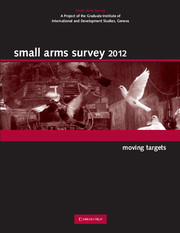Book contents
- Frontmatter
- Foreword
- Contents
- About the Small Arms Survey
- Notes to readers
- Acknowledgements
- Introduction
- Chapter 1 A Fatal Relationship: Guns and Deaths in Latin America and the Caribbean
- Chapter 2 When Business Gets Bloody: State Policy and Drug Violence
- Chapter 3 A Matter of Survival: Non-lethal Firearm Violence
- Chapter 4 Blue Skies and Dark Clouds: Kazakhstan and Small Arms
- Chapter 5 Between State and Non-state: Somaliland's Emerging Security Order
- Photo Essay. Troubled Waters: Somali Piracy
- Chapter 6 Escalation at Sea: Somali Piracy and Private Security Companies
- Chapter 7 Precedent in the Making: The UN Meeting of Governmental Experts
- Chapter 8 Piece by Piece: Authorized Transfers of Parts and Accessories
- Chapter 9 Point by Point: Trends in Transparency
- Chapter 10 Surveying the Battlefield: Illicit Arms in Afghanistan, Iraq, and Somalia
- Index
Chapter 1 - A Fatal Relationship: Guns and Deaths in Latin America and the Caribbean
Published online by Cambridge University Press: 05 February 2015
- Frontmatter
- Foreword
- Contents
- About the Small Arms Survey
- Notes to readers
- Acknowledgements
- Introduction
- Chapter 1 A Fatal Relationship: Guns and Deaths in Latin America and the Caribbean
- Chapter 2 When Business Gets Bloody: State Policy and Drug Violence
- Chapter 3 A Matter of Survival: Non-lethal Firearm Violence
- Chapter 4 Blue Skies and Dark Clouds: Kazakhstan and Small Arms
- Chapter 5 Between State and Non-state: Somaliland's Emerging Security Order
- Photo Essay. Troubled Waters: Somali Piracy
- Chapter 6 Escalation at Sea: Somali Piracy and Private Security Companies
- Chapter 7 Precedent in the Making: The UN Meeting of Governmental Experts
- Chapter 8 Piece by Piece: Authorized Transfers of Parts and Accessories
- Chapter 9 Point by Point: Trends in Transparency
- Chapter 10 Surveying the Battlefield: Illicit Arms in Afghanistan, Iraq, and Somalia
- Index
Summary
INTRODUCTION
Armed violence is a defining problem for contemporary Latin America and the Caribbean (Davis, 2006, p. 178). Many countries in the region suffer from rates of armed violence as high or higher than those in countries affected by war (Geneva Declaration Secretariat, 2011, pp. 51–65).
Some countries in the region not only show significantly higher homicide rates than countries elsewhere, but their security situation is also deteriorating. Homicide rates are generally increasing, and the brutality of the violence in some countries can be extraordinary. For example, in May 2011, neighbours of a remote ranch in northern Guatemala found the bodies of 27 farm workers, including two women and three teenagers. All but two had been decapitated (ICG, 2011, p. 2). While the killings were gruesome, even by the standards of the country's long history of violence, attacks of this kind are not unheard of in several countries in Latin America and the Caribbean.
Firearms are a defining feature of armed violence in the region. Specifically, the proportions of homicides committed with firearms in the majority of countries in Latin America and the Caribbean are higher than elsewhere in the world, although they vary considerably within the region. To date, firearm homicide levels and trends have not been subject to any comprehensive reviews; nor have studies been carried out on the types of firearms most commonly used in the region.
- Type
- Chapter
- Information
- Small Arms Survey 2012Moving Targets, pp. 8 - 39Publisher: Cambridge University PressPrint publication year: 2012
- 1
- Cited by



